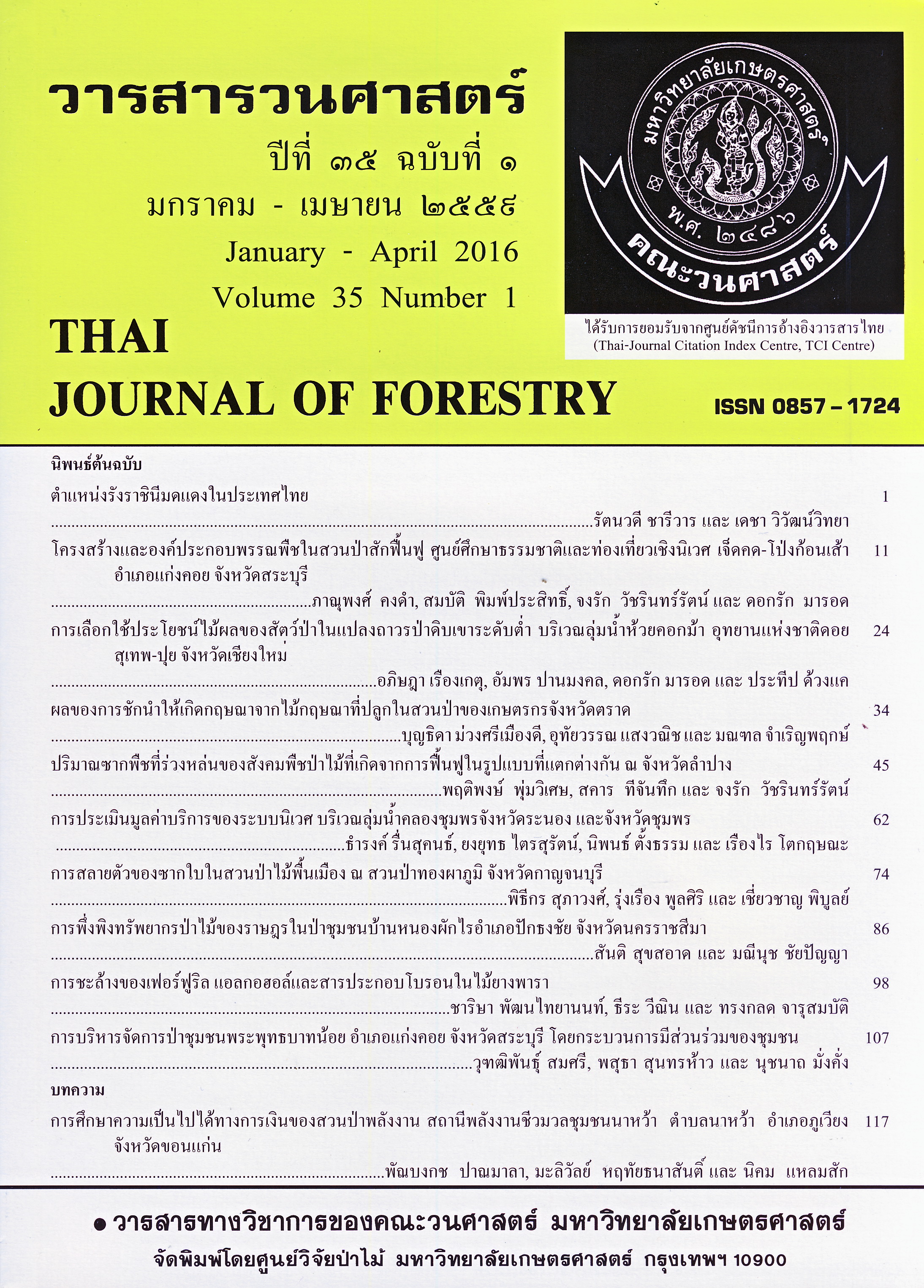ปริมาณซากพืชที่ร่วงหล่นของสังคมพืชป่าไม้ที่เกิดจากการฟื้นฟู ในรูปแบบที่แตกต่างกัน ณ จังหวัดลำปาง
Main Article Content
บทคัดย่อ
ทำการศึกษาปริมาณการร่วงหล่นของซากพืชของสังคมพืชได้จากดำเนินการฟื้นฟูพื้นที่มีระบบนิเวศป่าไม้เสื่อมโทรมที่มีอายุประมาณ 15 ปี ในพื้นที่อำเภอแม่เมาะ จังหวัดลำปาง คือ การบูรณะให้เกิดผลผลิตใหม่ (forest reclamation) ที่เหมืองแม่เมาะ การฟื้นฟูผลผลิต (forest rehabilitation) ที่สวนป่าแม่เมาะ และการฟื้นฟูระบบนิเวศ (forest restoration) ที่แปลงปลูกป่าถาวรเฉลิมพระเกียรติฯ (FPT7) ตำบลจางเหนือ โดยวางแปลงตัวอย่างในป่าทั้ง 3 พื้นที่ พื้นที่ละ 3 แปลง โดยใช้แปลงตัวอย่างขนาด 40×20 เมตร แบ่งแปลงย่อยขนาด 10×10 เมตร ติดตั้งกระบะรองรับซากพืช (litter trap) ขนาด 1 × 1 เมตร สูงจากพื้นดิน 1 เมตร มีตาข่ายรองรับซากพืชลึก 0.7 เมตร ที่บริเวณกลางแปลงย่อยทุกแปลง ทำการเก็บข้อมูลปริมาณการร่วงหล่นของเศษซากพืชโดยแยกเป็นปริมาณส่วนต่างๆ คือ ใบ กิ่ง เปลือก ส่วนสืบพันธุ์ และอื่นๆ ของทุกเดือนที่ดำ เนินการศึกษาวิจัยเป็นเวลา 12 เดือน คือ ตั้งแต่เดือนเมษายน พ.ศ. 2554 ไปจนถึงเดือนมีนาคม พ.ศ. 2555 ผลการศึกษาพบว่าสังคมพืชที่ได้จากการฟื้นฟูพื้นที่ผ่านการทำเหมืองแร่ (เหมืองแม่เมาะ) มีปริมาณการร่วงหล่นของซากพืชสูงสุด ประมาณ 8.43 ตันต่อเฮกแตร์ต่อปี รองลงมาคือ สังคมพืชที่ได้จากการฟื้นฟูระบบนิเวศ(ป่าถาวรเฉลิมพระเกียรติฯ) ประมาณ 7.99 ตันต่อเฮกแตร์ต่อปี และน้อยที่สุดคือ สังคมพืชที่ได้จากการฟื้นฟูแบบเพิ่มผลผลิต (สวนป่าแม่เมาะ) ประมาณ 5.12 ตันต่อเฮกแตร์ต่อปี โดยปริมาณผลผลิตซากพืชรวมรายเดือนของแต่ละสังคมพืช มีแนวโน้มผันแปรไปตามปริมาณผลผลิตซากพืชส่วนที่เป็นใบ ปริมาณผลผลิตซากพืชมีความสัมพันธ์ในทางตรงกันข้ามกับปริมาณนำ้ฝน อุณหภูมิและความชื้นสัมพัทธ์ ส่วนปัจจัยแวดล้อมอื่นๆ พบว่า จำนวนชนิดพันธุ์ที่พบความสูงของไม้ พื้นที่หน้าตัดของไม้ ความหนาแน่นของไม้ และปริมาณมวลชีวภาพเหนือพื้นดิน มีความสัมพันธ์ในทิศทางเดียวกันกับปริมาณผลผลิตซากพืช พบว่าปริมาณซากพืชรายปีนั้นมีความแตกต่างกันอย่างมีนัยสำคัญทางสถิติโดยส่วนใหญ่แล้วสังคมพืชที่ได้จากการฟื้นฟูพื้นที่ผ่านการทำเหมืองแร่ (เหมืองแม่เมาะ) จะถูกจัดอยู่ในกลุ่มเดียวกับ
สังคมพืชที่ได้จากการฟื้นฟูระบบนิเวศ (ป่าถาวรเฉลิมพระเกียรติฯ) เนื่องจากความหนาแน่นของไม้และปริมาณมวลชีวภาพเหนือพื้นดินที่มีค่าใกล้เคียงกันของทั้งสองสังคม
Downloads
Article Details
ข้าพเจ้าและผู้เขียนร่วม (ถ้ามี) ขอรับรองว่า ต้นฉบับที่เสนอมานี้ยังไม่เคยได้รับการตีพิมพ์และไม่ได้อยู่ในระหว่างกระบวนการพิจารณาตีพิมพ์ลงในวารสารหรือสิ่งตีพิมพ์อื่นใด ข้าพเจ้าและผู้เขียนร่วม (ถ้ามี) ยอมรับหลักเกณฑ์และเงื่อนไขการพิจารณาต้นฉบับ ทั้งยินยอมให้กองบรรณาธิการมีสิทธิ์พิจารณาและตรวจแก้ต้นฉบับได้ตามที่เห็นสมควร พร้อมนี้ขอมอบลิขสิทธิ์ผลงานที่ได้รับการตีพิมพ์ให้แก่วารสารวนศาสตร์ คณะวนศาสตร์ มหาวิทยาลัยเกษตรศาสตร์ กรณีมีการฟ้องร้องเรื่องการละเมิดลิขสิทธิ์เกี่ยวกับภาพ กราฟ ข้อความส่วนใดส่วนหนึ่ง หรือ ข้อคิดเห็นที่ปรากฏในผลงาน ให้เป็นความรับผิดชอบของข้าพเจ้าและผู้เขียนร่วม (ถ้ามี) แต่เพียงฝ่ายเดียว และหากข้าพเจ้าและผู้เขียนร่วม (ถ้ามี) ประสงค์ถอนบทความในระหว่างกระบวนการพิจารณาของทางวารสาร ข้าพเจ้าและผู้เขียนร่วม (ถ้ามี) ยินดีรับผิดชอบค่าใช้จ่ายทั้งหมดที่เกิดขึ้นในกระบวนการพิจารณาบทความนั้น”
เอกสารอ้างอิง
Ashton, P.S. 1964. Ecological Studies in The Mixed Dipterocarp Forest of Brunei State. Clarendon Press, Oxford.
Ashton, P.S. and P. Hall, 1992. Comparisons of structure among mixed dipterocarp forests of northwestern Borneo. Journal of Ecology 80: 459-481.
Bunyavejchewin, S., B. Puriyakorn and S.Kiratiprayoon. 1987. Litterfall and net primary productivity in spacing trial plots of EUCALYPTUS CAMALDULENSIS. Thai Journal of Forestry 6: 239-249.
Celentano, D., R.A. Zahawi., B. Finegan., R. Ostertag., R.J. Cole. and K.D. Holl. 2011. Litterfall dynamics under different tropical forest restoration strategies in Costa Rica. BIOTROPICA 43 (3): 279-287.
Condit, R., S.P. Hubbell and R.B. Foster. 1996. Changes in a tropical forest with a shifting climate: results from a 50 ha permanent census plot in Panama. Journal of Tropical Ecology 12: 231-256.
FRIS. 2003. WCMC Forest Restoration: Forest Restoration Information Service. Concepts and Definitions. Available Source: http://www.unepwcmc.org/forest/restoration /concepts.htm, May 28, 2010
Gentry, A.H. 1992. Bignoniaceae – part II(tribe Tecomeae). Flora Neotropica Monograph 25 (II): 273-293.
Harris, F. 2012. Human-environment interactions, pp. 3-18. In F. Harris, ed. Global Environmental Issues. John Wiley & Sons Inc., New York.
Hubbell, S.P. and R.B. Foster. 1985. Biology, chance, and history, and the structure of tropical rain forest communities, pp. 314-332. In J.M. Diamond and T.J. Case, ed. Community Ecology. Harper and Row., New York.
Jampanin, S. 2004. Comparison of litter Production and litter Decomposition for Carbon Sequestration Assessment in Forest Ecosystems at Kaeng Krachan National Park, Thailand. M.S. Thesis, Chulalongkorn University. (in Thai)
Klinge, H. 1974. Litter Production on Tropical Ecosystem. The IBP-Synthesis, Kuala Lumpur. (Unpublished manuscript)
Kunhamu, T.K., B.M. Kumar and S. Viswanath. 2009. Does thinning affect litterfall, litter decomposition, and associated nutrient release in Acacia mangium stands of Kerala in peninsular India?.Canadian Journal of Forest Research 39 (4): 792-801.
Philips, O.L. and A.H. Gentry. 1994. Increasing turnover through time in tropical forests. Science 263: 954-958.
Sahunalu, P. 1987. Primary Production of Trpical Forests. Kasetsart Universtiy, Bangkok. (mimeographed)
Spain, A.V. 1984. Litter fall and the standing crop of litter in three tropical Australian rain forest. Journal of Ecology 72: 947-961.
Whitmore, T.C. 1990. An Introduction to Tropical Rain Forest. Oxford University Press, Oxford.
Williams-Linera, G. and J. Tolome. 1996. Litterfall, temperate and tropical dominant trees, and climate in a Mexican lower montane forest. BIOTROPICA 28 (4): 649-656


